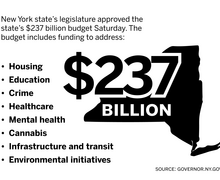SUNY-ESF faculty members rescue formerly ‘extinct’ tortoise species to breed
Courtesy of Bill Corbett
The tortoise population on Pinta has been missing for more than a century and as a result the plant community has changed.
In the late 1800s, whalers and pirates would take tortoises from the islands of Pinta and Floreana to use as food on their ships, leading to the supposed extinction of these tortoises.
James Gibbs, a conservation biologist from the SUNY-ESF, is a member of a group of scientists who recently returned from a research expedition to the Galapagos Islands in search for a strain of these tortoises that until recently was believed to be extinct.
When Lonesome George, a Pinta tortoise, passed away in 2012, it was thought to be the end of the species. However, a new hybrid Pinta species was discovered. The focus of this expedition was to rescue some of these tortoises so that they could be bred in captivity.
Donald Leopold, the chair of the environmental and forestry biology department at SUNY-ESF, said even today people are finding species of plants and animals that they thought were extinct across the globe.
“The Galapagos is unique because it is a series of these islands where species were unique to those islands, so (there are) … a lot of things that look similar but are actually quite different island-to-island because they spent so many hundreds of thousands of years on those islands all isolated,” Leopold said.
He added that when the sailors came in and began moving things around and eliminating the tortoises, it had a negative effect on the islands’ ecosystems.
Elizabeth Hunter, a SUNY-ESF alumna, first became involved in Galapagos research in 2010 when she was working toward her Master’s degree under Gibbs. Her research focused on a group of sterilized tortoises that were introduced to Pinta Island to help fulfill the ecosystem functions of the extinct Pinta tortoise.
“Giant tortoises are also a conservation icon, and so resurrecting these species takes on a global importance that is larger than the Galapagos,” Hunter said in an email.
Giant tortoises are ecosystem engineers in many ways, Hunter said. For example, they structure the plant community through their disturbance, herbivory and seed dispersal, Hunter said. The tortoise population on Pinta has been missing for more than a century and as a result the plant community has changed, she said.
During a 2008 expedition, about 1,600 tortoises with the Pinta and Floreana genes were found, marked and identified based on blood samples. Based on that sampling, a list of high-priority tortoises was created, and these tortoises were searched for during this expedition, Hunter said.
Once a tortoise was identified as being high-priority, it was transported off the island. With helicopter support, the tortoises were airlifted using a net and kept on a ship until they could be transported back to Santa Cruz Island, where they are currently being kept in a captive breeding center, she said.
Hunter said this kind of species resurrection — restoring an extinct species from hybrid individuals — is unprecedented. She said this won’t be a true success until the tortoises can begin breeding and their progeny can be restored to the islands, which could take decades.
“It’s important that we conserve endangered species before they become extinct as resurrecting them is clearly a time- and resource-intensive endeavor,” Hunter said.
Leopold said conservation is not a field that people should be dismissing because they think all the work has been done.
“This is probably the most important time in the history of the world for people to be thinking about conservation of plants and animals and habitats,” Leopold said.
Published on December 6, 2015 at 10:09 pm
Contact Anjali: acalwis@syr.edu




